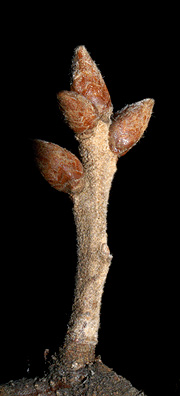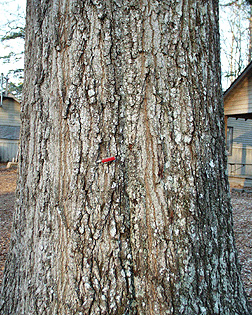southern red oak Fagaceae Quercus falcata
Leaf:Alternate, simple, 5 to 9 inches long and roughly obovate in outline with bristle tipped lobes. Two forms are common: 3 lobes with shallow sinuses (common on younger trees) or 5 to 7 lobes with deeper sinuses. Often resembles a turkey foot with one very long hooked terminal lobe with two shorter lobes on the sides. Shiny green above, paler and fuzzy below.
Flower:Species is monoecious; males yellow-green (tinged with red) borne on long thread like catkins; females reddish and borne on short spikes, both appearing in spring with the leaves.
Fruit:Acorns are 1/2 inch long, orange-brown and pubescent. The cap covers less than 1/3 of the nut and is quite thin and flattened; cap scales are orange-brown, appressed and slightly pubescent; matures after two years, ripens in the fall.
Twig:Reddish brown in color, may be gray-pubescent (particularly rapidly growing stems such as stump sprouts) or glabrous; multiple terminal buds are dark reddish brown, pubescent, pointed and only 1/8 to 1/4 inch long, laterals buds are similar, but shorter.
Bark:Dark in color, thick, with broad, scaly ridges separated by deep, narrow furrows. Resembles Q. velutina, but the inner bark is only slightly yellow.
Form:A medium sized tree up to 90 feet tall with a rounded crown.







Notes: